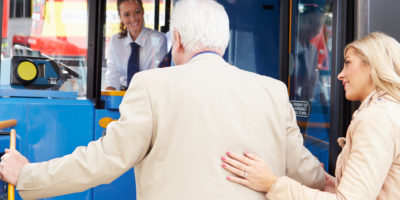There are currently more than 6 million people living with Alzheimer’s disease in the United States. Currently, about 70 percent of them are living in the community and 25% are living alone. People with dementia can lead fulfilling lives when they are able to remain socially active in the community. The availability of accessible transportation is vital to achieve this goal. Typical accommodations for people with disabilities include wheelchair ramps, audio announcements of upcoming bus stops, priority seating, and curb-cuts. Other forms of accommodation that are less apparent will need to be considered to ensure individuals living with Alzheimer’s disease or other dementia have transportation services that meet their unique needs.
 Memory loss is the most recognized symptom of dementia; however, individuals with the disease also experience confusion, difficulty completing familiar tasks, decreased judgement and problems with communication. This can make using public transportation a challenge. Tasks including arranging the ride, getting to the vehicle, paying for the ride, remembering where they are going and how to get back are all potential roadblocks for a person with dementia to utilize public transportation.
Memory loss is the most recognized symptom of dementia; however, individuals with the disease also experience confusion, difficulty completing familiar tasks, decreased judgement and problems with communication. This can make using public transportation a challenge. Tasks including arranging the ride, getting to the vehicle, paying for the ride, remembering where they are going and how to get back are all potential roadblocks for a person with dementia to utilize public transportation.
Transit providers need to keep the unique needs of individuals with dementia in mind and create a plan to accommodate these needs. A successful plan should include collaboration with community partners, education and training for staff and volunteers, and offering a travel training program that will make transit services welcoming and usable for people with dementia.
Collaboration with community partners
Establishing partnerships with organizations that work with people who have dementia is an essential step in developing accessible transportation programs. Good partners include the Alzheimer’s Association, Aging & Disability Resource Centers (ADRCs), and Area Agencies on Aging (AAAs) as they can provide valuable insight on ways to accommodate individuals with dementia, and can assist in spreading the word about your transportation program. These agencies also provide caregiver support programs which include access to transportation services. Additionally, since the National Alzheimer’s Project Act (NAPA) was signed into law in 2011, the establishment of dementia-friendly community initiatives is growing in number along with projects focused on building age-friendly communities. These coalitions are important groups to collaborate with when developing transportation programs accessible to individuals with dementia.
National Plan to Address Alzheimer’s Disease
In 2011, the National Alzheimer’s Project Act (NAPA) was signed into law, calling for a coordinated national plan to provide improved care and services for people living with dementia and their families. Since then, a myriad of programs have spread across the country including Dementia Friendly America and Dementia Friends USA which are working to make communities more livable for individuals living with dementia and their caregivers.
Education and training
Because symptoms of dementia vary widely, it is not always easy to identify someone who has the disease nor is there a single method for interacting with them. Therefore, it is important for transportation program staff and volunteers to have a basic understanding of the disease and know the best ways to help and support individuals with dementia. Dementia coalitions and the Alzheimer’s Association can provide dementia training to community partners as a core component of their mission. Transportation providers can contact the local Aging & Disability Resource Center or Area Agency on Aging to find dementia training for their staff.
Travel training program
Navigating a transit system can be complicated for anyone. For individuals with dementia the process may be intimidating enough to prevent them from even trying. One solution is to develop a travel training program to offer support, education and training to help riders understand the transit system and teach the skills needed to successfully use them. In addition to individual or group instruction some agencies provide a paid staff or volunteer to ride with new riders. Intercity Transit based in Olympia, Washington has enlisted volunteers to become “Bus Buddies” to offer additional assistance and build confidence in their ability to use the transit system.
Our nation has a growing number of individuals living with dementia who want and need to stay active in their communities for as long as possible. It is imperative that transportation programs respond to this growing need and become adept at developing services that meet the unique needs of people with dementia and memory loss.
For additional information:
NADTC Dementia, Caregiving and Transportation Toolkit
NADTC Brochure: Dementia, Caregiving and Transportation
NADTC Brochure: Assisting Passengers with Alzheimer’s and Dementia
This blog was written by Jane Mahoney, Training & Technical Assistance Specialist for the National Aging & Disability Transportation Center and Easterseals.
Leave a Reply